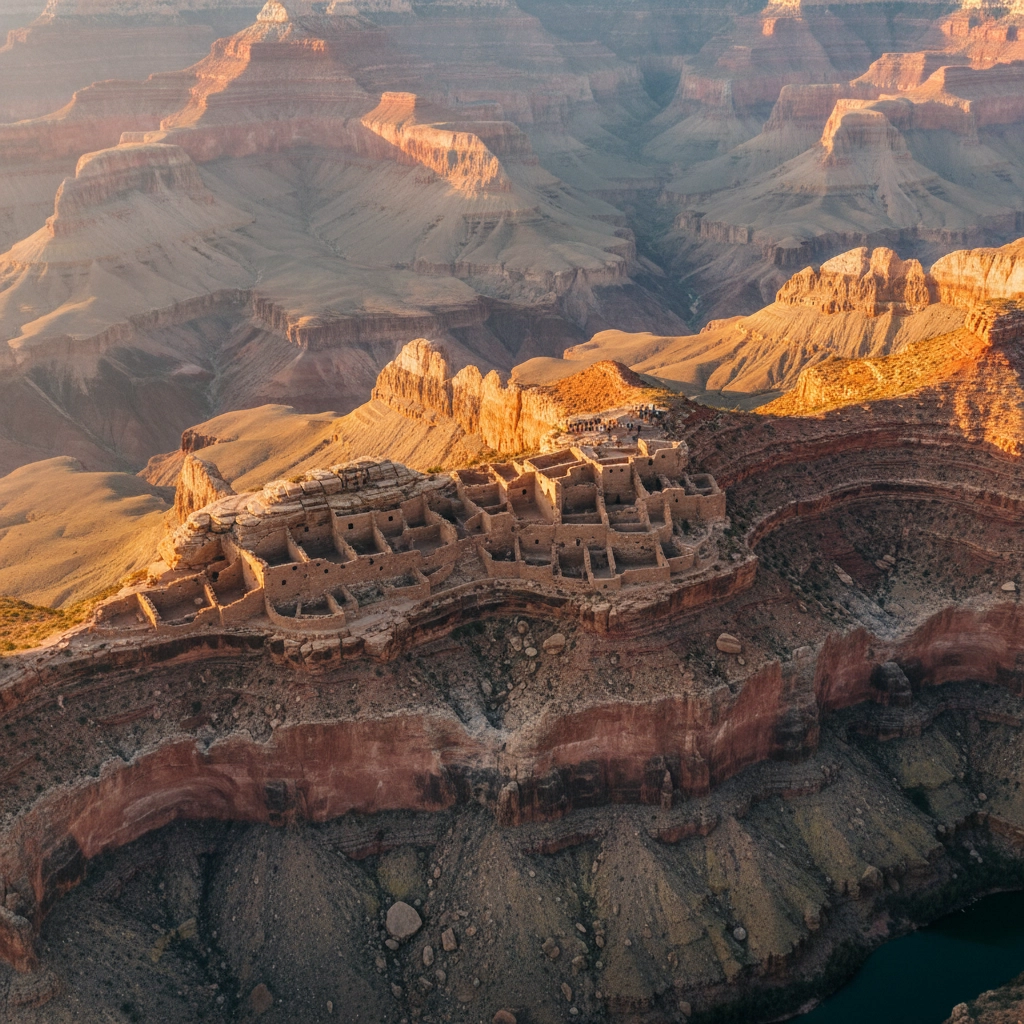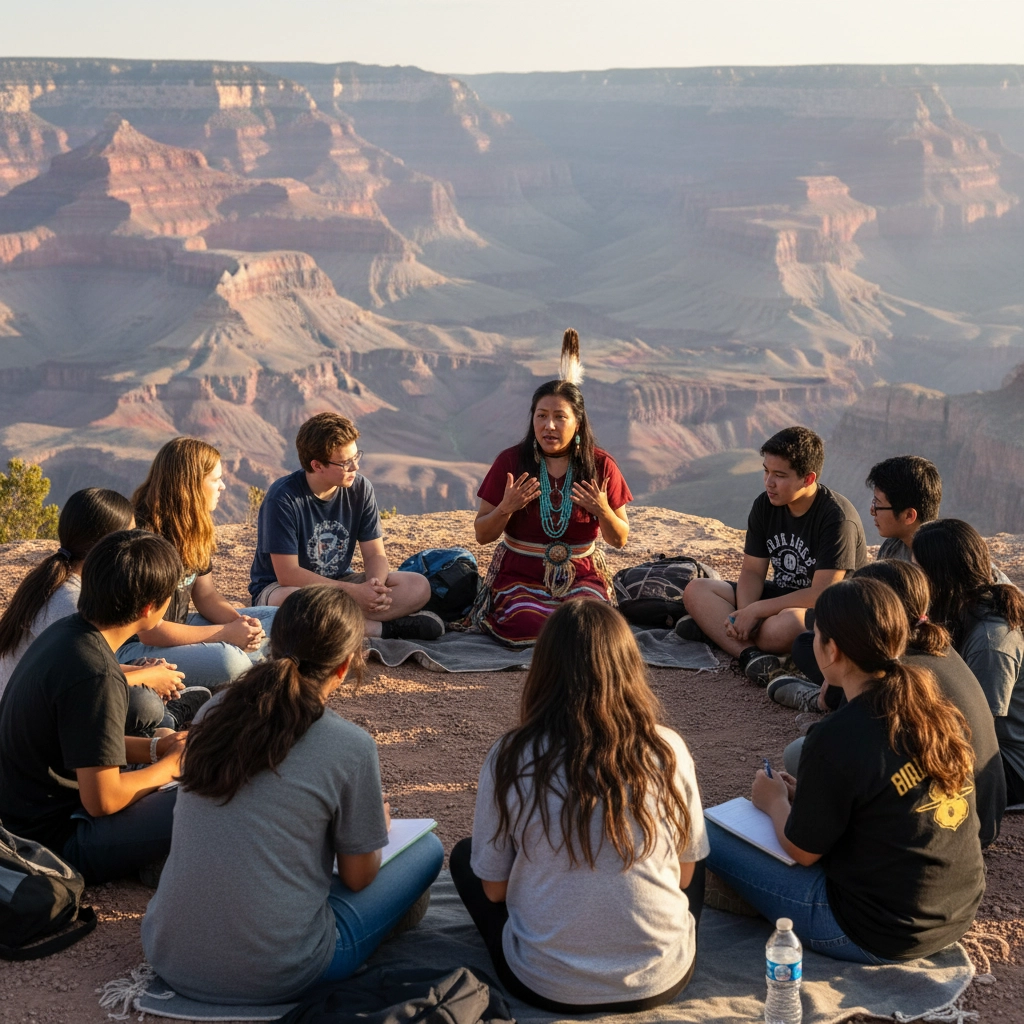Exploring Native American History on a Student Trip to the Grand Canyon
- Caleb Mullenix
- 22 hours ago
- 5 min read
Ensuring your students experience the profound cultural heritage of the Grand Canyon requires understanding that this natural wonder represents far more than geological formations: it serves as one of North America's most significant Native American cultural landscapes. Preparing your students to engage respectfully and meaningfully with 11,000 years of indigenous history demands careful planning and cultural sensitivity.
Understanding the Deep Historical Context
Begin by researching the extensive timeline of human presence at the Grand Canyon. Archaeological evidence confirms human habitation spanning at least 10,500 years, with continuous Native American occupation for over 4,000 years. Emphasize to your students that they will be walking through landscapes where indigenous peoples have lived, worked, and maintained spiritual connections across millennia.
The Ancestral Pueblo peoples, previously known as the Anasazi, established significant settlements beginning around 200 C.E. Create opportunities for students to examine approximately 2,000 known archaeological sites within park boundaries, including the accessible Tusayan Pueblo, constructed around 1185 C.E. and housing approximately 30 people.
Discuss the climate-driven migration that occurred between 1276-1299 C.E., when severe drought forced both Ancestral Pueblo and Cohonina cultures to relocate. Explain how this historical event connects to modern Hopi communities and the 19 Pueblos of New Mexico, where many descendants live today.

Key Tribal Nations and Their Connections
Focus your educational planning on the 11 federally recognized tribes that maintain historic connections to Grand Canyon National Park. Prioritize learning about these primary tribal nations:
The Havasupai Nation - meaning "people of the blue-green water" - has inhabited the canyon for over 1,000 years. Their reservation borders the park, and students can learn about their sustainable relationship with Havasu Falls and surrounding waters.
The Hopi Tribe views the Grand Canyon as their spiritual birthplace, where ancestors first emerged to live on earth. Emphasize the canyon's role in Hopi creation stories and cosmology.
The Navajo Nation (Diné) maintains the largest reservation bordering the park. Discuss their later arrival to the region and their current cultural preservation efforts.
The Hualapai Tribe controls significant canyon access points and offers educational programs. Their name means "people of the tall pines."
The Zuni Pueblo connects the canyon to their origin stories and conducts spiritual pilgrimages to the area.
Create detailed itineraries that acknowledge how these tribal reservations surround and border the national park, particularly the Navajo and Hopi reservations to the west and the Havasupai and Hualapai reservations to the south.
Spiritual and Cultural Significance for Educational Context
Prepare students to understand the Grand Canyon's profound spiritual meaning for Native American communities. Establish clear guidelines for respectful behavior when discussing or observing sacred sites and cultural practices.
Explain to students that for the Hopi, the canyon represents their spiritual birthplace and creation origin. Emphasize that this connection involves active spiritual practices, ceremonies, and rituals honoring ancestors and land spirits. Ensure students understand they are entering a living cultural landscape, not merely observing historical artifacts.
Discuss how the Havasupai demonstrate sustainable living practices that have maintained ecological balance for over a millennium. Create opportunities for students to examine traditional ecological knowledge and its applications to modern conservation challenges.
Address the Zuni perspective of the canyon as a pilgrimage destination and starting point for their people's journey. Help students appreciate how physical landscapes connect to cultural identity and spiritual practice across generations.

Educational Programs and Learning Opportunities
Research and coordinate with the hundreds of educational programs hosted by tribal communities. Prioritize direct learning from tribal members rather than external interpretations of Native American history and culture.
Archaeological Site Visits
Schedule guided tours of Tusayan Pueblo for hands-on archaeological learning
Plan visits to the Anasazi Granary carved in Redwall Limestone near Nankoweap Trail
Create assignments connecting ancient engineering solutions to modern environmental challenges
Cultural Programs
Coordinate with tribal education departments for authentic cultural presentations
Arrange traditional craft workshops led by tribal artisans
Schedule storytelling sessions featuring creation stories and oral histories
Contemporary Connections
Plan meetings with tribal council members or cultural preservation officers
Organize discussions about modern tribal governance and cultural continuity
Create opportunities to learn about current environmental stewardship efforts
Planning Considerations for Educators
Develop comprehensive preparation protocols that emphasize cultural sensitivity and respect. Contact tribal cultural centers and education departments months in advance to coordinate appropriate learning experiences.
Pre-Trip Preparation Requirements:
Research each tribe's current cultural protocols and visitor guidelines
Prepare students with background knowledge about federal recognition and tribal sovereignty
Discuss the difference between historical study and living cultures
Establish clear behavioral expectations for sacred or culturally sensitive areas
Safety and Respect Protocols:
Emphasize that photography may be restricted at certain sites or during cultural activities
Discuss appropriate questions and topics for tribal educators
Create guidelines for respectful listening during cultural presentations
Establish procedures for handling sacred objects or ceremonial items

Maximizing Educational Impact Through Structured Learning
Design your itinerary to connect multiple learning objectives across disciplines. Integrate Native American perspectives into geology, ecology, archaeology, anthropology, and contemporary social studies curricula.
Cross-Curricular Integration Strategies:
Compare ancient agricultural techniques with modern farming practices
Analyze traditional ecological knowledge and its scientific applications
Examine tribal governance structures and their relationship to federal systems
Study language preservation efforts and cultural continuity challenges
Assessment and Reflection Activities:
Create portfolios documenting cultural learning experiences
Assign research projects on specific tribal nations and their contemporary issues
Develop presentations connecting historical knowledge to current events
Encourage journaling about personal perspectives and cultural understanding growth
Practical Implementation Guidelines
Coordinate logistics carefully to ensure meaningful cultural engagement while respecting tribal protocols. Contact tribal tourism departments and education coordinators to establish appropriate visit parameters.
Schedule adequate time for each cultural learning component rather than rushing through multiple experiences. Emphasize quality engagement over quantity of activities.
Provide students with cultural context guides and vocabulary lists before departure. Ensure they understand terms like "tribal sovereignty," "federal recognition," and "cultural preservation."
Create structured reflection time during the trip for students to process cultural learning experiences. Encourage respectful questions and discussions that deepen understanding rather than perpetuating stereotypes.
Plan follow-up activities that maintain student connection to Native American communities and contemporary issues. Consider ongoing correspondence with tribal education programs or continued research projects.
Essential Communication with Parents and Students:
Share detailed itineraries including all cultural components
Explain educational objectives and cultural sensitivity expectations
Provide background reading materials about tribal history and contemporary culture
Discuss appropriate behavior, dress codes, and interaction guidelines
The Grand Canyon offers unparalleled opportunities for students to engage with living Native American cultures while developing deeper appreciation for indigenous knowledge systems, spiritual practices, and contemporary challenges. Through careful planning, respectful preparation, and structured learning experiences, your students will gain invaluable perspectives on American history, cultural diversity, and the ongoing relationships between indigenous peoples and the landscapes they have called home for millennia.
Ensure that your Grand Canyon educational experience emphasizes the continuity between ancient peoples and modern tribal communities, helping students understand that Native American history continues to unfold today through vibrant, resilient cultures that maintain profound connections to this remarkable landscape.



Comments